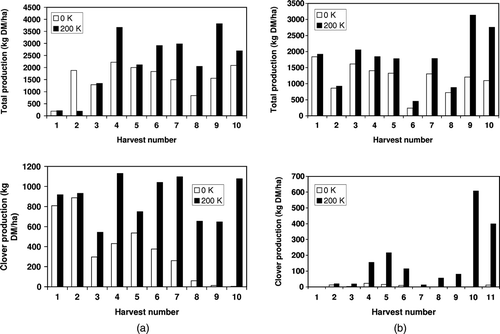Abstract
Field-trial data from a database comprising records of 804 potassium (K) fertiliser trials were used to define the production functions relating exchangeable soil K (quick test K (QTK) 0–75 mm) to the relative response to fertiliser K applications, for the major soil groups in New Zealand. For all soil groups for which there were sufficient data, the production functions were generally flat in the range QTK 5–10, and thus the estimated relative pasture production at QTK 5 and QTK 10 were similar. The critical QTK levels to achieve 97% maximum production were relatively well defined, being 6 (5–8) for sedimentary soils (brown and pallic) and brown soils, and 7 (5–10) for pumice soils. The data for the allophanic soils were unstable and the best estimate was 6 (5–10). For the remaining soils groups (podzols and raw soils, organic, recent and gley soils) for which there was much less data, the relationships were essentially flat over the range QTK 2–10. The probability of pasture responses to applied K increased as soil QTK decreased from 10. For the sedimentary and volcanic soils (including both allophanic and pumice) the probability was about 70–80% at soil QTK < 2. The comparable probabilities were 50–60% for the recent and gley soils, and 30–43% for the podzols and raw soils. A feature of the response functions was that some trials were not responsive to fertiliser K despite having low soil QTK. In most cases this could not be attributed to soil K reserves as measured by the soil TBK test (sodium tetra-phenol-boron extractable which measures exchangeable K plus plant-available but non-exchangeable K). Other possible reasons for this feature in the data are discussed, including uptake of K from below the soil sampling depth and the temporal effects of clover responses to applied K. Soil K buffer capacities—the amount of fertiliser K over and above maintenance required to increase soil QTK by 1 unit (ΔK)—ranged from 50 to > 150 kg K ha−1 (average 124) for sedimentary soils. For some soils (developed organic soils, gleyed soils and podzols), fertiliser K had very little effect on QTK (0–75 mm). It is not clear whether these differences are due to differences in leaching of K from the sampling depth, differences between soils in their ability to absorb and retain applied K or indeed the result of errors in the measurement of this parameter. Estimated maintenance K requirements (i.e. the amount of applied K required to maintain soil QTK levels) increased with increasing soil QTK from 4 to 10, from 0–150 kg K ha−1 yr−1 to 100–300 kg K ha−1 yr−1 in situations where losses of K were extreme due to the removal of all harvested clippings. Given the uncertainties in predicting K responses and the amount of fertiliser K required to correct K deficiency, practical suggestions are offered as to how best to diagnose and manage soil K deficiency. Areas for future research to improve the prediction of pasture responses to fertiliser K are also included.
Introduction
Inputs of fertiliser potassium (K) are essential for the maintenance of New Zealand's legume-based pastoral system. This arises because many New Zealand soils are inherently deficient in K, particularly those derived from parent materials depleted of K (allophanic soils, pumice soils, organic soils and raw soils (sands) using the classification of Hewitt (Citation1993)) and highly weathered soils (podzols). Furthermore, many of the soils derived from sedimentary parent materials (pallic and brown soils) are being, or have been, depleted of their natural K reserves by continuous farming over 50 to 100 years.
New Zealand has no indigenous sources of K minerals and now imports about 200 000 t of potash annually (Martin & Clarke Citation2000) to maintain soil K levels and hence maintain pasture production. This is likely to increase as agriculture becomes more intensive, land-use shifts increasingly from dry stock farming to dairying and more sedimentary soils are mined of their existing soil K reserves.
Beginning in the 1950s, many field trials were conducted to define the inputs of fertiliser K required to maximise pasture production on K-deficient soils, and these trials were used to calibrate a simple diagnostic soil test for K based on exchangeable K (quick test K (QTK)) (Hogg Citation1957). Hogg (Citation1957) reported that for soils of the North Island (mainly of volcanic origin—allophanic and pumice soils) and South Island (mainly sedimentary) where the rainfall was >1100 mm yr−1, pasture responses were unlikely if the soil QTK was >10 (approximately 200 µg g−1 soil). For the drier sedimentary soils (rainfall <1100 mm) QTK was not a good predictor of K responsiveness. Some soils with QTK levels <10 were not responsive to K applications. Metson (Citation1980) examined the mineralogy of soil K in relation to the genetic soil groups of New Zealand and demonstrated that the differentiation highlighted by Hogg (Citation1957) was due to fundamental differences in soil mineralogy. Soils derived from volcanic parent materials had very little reserve K (Kc; sequential extraction with 1 M HNO3 for 20 min at 1:100 soil:extractant ratio (Metson Citation1960, Citation1968)) whereas those from sedimentary origins had significant K reserves (depending on the degree of weathering) due to the presence of 2:1 layer micaceous minerals.
The methodology developed by Metson (Citation1960, Citation1968, Citation1980) to measure soil K reserves was not appropriate for routine soil testing, and Jackson (1985) developed a test based on sodium tetra-phenol-boron (TBK) to measure exchangeable K plus non-exchangeable but plant-available K. For 25 soils representing a wide range of soil K status, the TBK test gave the highest correlation with K uptake by ryegrass, in an exhaustive pot experiment, relative to the other tests he examined. Jackson did note, however, that the TBK test would not predict pasture responses to fertiliser K accurately on soils where the rate of release of reserve K was less than the plant demand and in situations where the plants derived significant amounts of K from below the soil depth tested. In subsequent field work on pastoral soils on the West Coast, it was found that exchangeable K was superior to the TBK method in terms of predicting K responses (Williams et al. Citation1986), but these results were on soils with a narrow range of exchangeable soil K.
Campkin (Citation1985) published a model for calculating the potassium requirements for grazed pastures. This model assumed that the soil-pasture-animal system was at a steady state with respect to soil K, and hence the fertiliser K requirements were calculated as the sum of all the losses of K from the system. The soil's ability to supply K for plant uptake from K reserves was accommodated by assigning soils to three categories based on the Kc test developed by Metson (Citation1980). Using this model, Williams et al. (Citation1990) compared predicted losses with estimates of actual losses derived from K balance considerations on three dairy farms on different soils and in different regions. They suggested some refinements to the model accordingly. Kirkman et al. (Citation1994) and Surapaneni et al. (Citation2002) were critical of this approach because they found that soils within any one of these Kc categories can exhibit a wide range of plant-available reserve K. Nevertheless the essence of this model is now incorporated in the OVERSEER® software (Wheeler personal communication) used by consultants to provide fertiliser advice to farmers.
Carey & Metherell (Citation2003a) further explored application of the TBK test by examining the kinetics of the release of reserve K and, based on this, suggested a further modification to the test. They also (Carey & Metherell Citation2003b) used the TBK test to monitor long-term changes in soil K reserves in field trials. They noted that measured levels of reserve K did not always reflect pasture K uptake and removal and attributed this to the uptake of soil K from below the soil sampling zone.
As part of a major revision of the scientific basis for fertiliser P, K and S advice in New Zealand, a large database of records from field trials examining the effects of fertiliser phosphorous (P), K and sulphur (S) on pasture production was compiled (Edmeades Citation1995, Edmeades et al. Citation2005, Citation2006). From this information the production functions relating pasture production and soil K (QTK) were derived, together with data on soil K buffer capacity (the amount of fertiliser K required to increase QTK by one unit in the field). This information was published informally for the benefit of consultants and farmers (Morton & Roberts Citation1999; Roberts & Morton Citation1999). The purpose of this review is to update the database with information from nine trials completed since the original database was compiled and to formally publish this material in the scientific literature.
Methods
Description of database
A complete description of the database is provided elsewhere (Edmeades et al. Citation2006) together with information on the criteria used for selecting the trials, the quality control parameters and the computational method used in the data analysis. In brief, the following information was recorded for each trial: site history, topography, aspect and soil group; pasture type and composition; farm type; trial design and treatments including basal applications of nutrients; commencement date and duration; and the pasture measurement technique. Within each trial, the treatment effects on pasture and animal production, botanical composition, pasture and soil nutrient concentration, and any visual assessments, were recorded, if available, at the individual harvest or measurement level. To preserve the integrity of the information, the residual degrees of freedom (derived from the overall analysis of variance of the trial) were recorded, together with a subjective assessment of the reliability of the trial. If the trial appeared to be professionally conducted throughout its duration with few unforeseen problems, it was judged superior and given a rating of 1; if problems arose that may have affected the veracity of the results it was given a ‘problem’ category of 3, otherwise it was rated as ‘average’ with a rating of 2.
Of the 3595 P, K and S trials recorded, there were 804 trials with at least two K treatments, including a control. The effect of treatment on pasture dry matter (DM) production was measured on 575 trials, and of these, 6 trials included treatment × animal production records. These K trials were distributed geographically as follows: northern North Island (287), southern North Island (248), northern South Island (103), southern South Island (166).
To determine the relationships between relative pasture yield and soil K (QTK), trials were extracted from the database that had at least four rates of fertiliser K (including zero), in which pasture DM had been assessed under continuous cutting (normally with clippings returned) and in which there were no other nutrients, except N, limiting pasture growth. These trials also had to have a corresponding QTK (0–7.5 mm) measurement on a per-treatment basis at the end of the year. The end-of-year soil K values were used as they reflected the effect of fertiliser K, and hence pasture production, during the previous 12 months. The maximum pasture production for each trial was calculated from the asymptotic, estimated using the Bayesian smoothing program Flexi (Upsdell Citation1994), and relative yields were obtained. For a given soil group classification, the relative yields were then plotted against the soil K.
Some of the field trials were conducted on a ‘clippings removal’ basis (i.e. all the pasture produced was set aside from the trial area). Thus it was possible to compare the production functions generated from this subset with trial data where all the pasture clippings were returned to the respective plots. Similarly, there was a subset of trials for which both the soil QTK and TBK were available, allowing this contrast to be made.
For estimating soil K buffering capacity (ΔK, the amount of fertiliser K to increase soil QTK by one unit), only those trials with soil QTK (0–7.5 mm) on a per-treatment basis for at least two years were used. Each trial had to have a minimum of four rates of K fertiliser, possibly including zero. Virtually all trials had a pre-trial soil test. As the relationship between soil test and time for a given rate of fertiliser is not linear in the long term (over the years of the trial), the data used for this assessment were limited to a maximum of two years. Based on previous experience (Edmeades et al. Citation2006), the following model was fitted to the data for each trial using Genstat 2005 (VSN Citation2005)
Pasture production functions
The relationships between relative pasture production and soil QTK (the K production functions) for those soil groups for which there was sufficient data are given in , noting that these functions represent the average annual relative production for a given average annual soil QTK level, based on end of year measurements. They are best interpreted as the relative pasture yields associated with maintaining given soil QTK levels.
Fig. 1 The relationships between relative pasture production and soil K (exchangeable K as measured by a quick test (soil QTK) (Hogg Citation1957)) for (A) sedimentary soil (brown plus pallic soils), (B) brown soils, (C) allophanic soils, (D) pumice soils, (E) podzols and raw soils (sands), (F) recent soils, (G) gley soils and (H) organic soils. The hatched bands are the 95% confidence intervals.
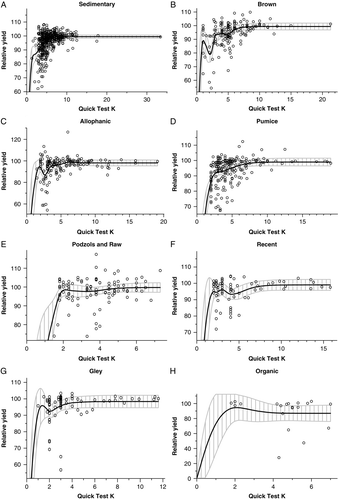
For podzols & raw soils (sands), organic, recent and gley soils, the relationships are essentially flat in the range QTK 2–10. This could be due to the lack of data from trials on these soils. More data were available for trials on soils derived from sedimentary parent materials (including both brown and pallic soils and referred to in this paper as the sedimentary soils), allophanic and pumice soils (referred to collectively as volcanic soils). For these soil groups, relative pasture production increased with increasing soil QTK to a maximum. The curves for the brown and allophanic soils show irregularities but these are unlikely to have any biological meaning and simply reflect the intrusion of uncontrolled variability in these functions. This feature of fitting Flexi curves has been noted earlier in respect to phosphorus production functions (Edmeades et al. Citation2006).
From these relationships it is possible to estimate, by interpolation, the relative pasture production and confidence interval at soil QTK 5 and 10, and also the critical levels (determined by convention to be the QTK required to achieve 97% of maximum production) (). shows little difference in the relative yields at QTK 5 and 10 for all the soil groups, and consequently the ranges in the estimated critical levels are broad, especially for the podzols & raw, organic, recent and gley soils, as noted. The relative yields at QTK 5 and 10, and the critical levels for the brown and pallic soils taken together and the subset of brown soils are similar, allowing for experimental error. In other words, it is not possible, given this set of data, to separate the drier and hence less weathered pallic soils, which typically have larger amounts of reserve K (Metson Citation1980), from the brown soils, in terms of the response to fertiliser K application. Similarly, allowing for the uncontrolled variability in the data, the relationships between soil QTK and relative pasture production are similar for the major soil groups (allophanic, pumice and sedimentary).
Table 1 Estimated relative pasture production and confidence intervals (P<0.05) at soil QTK levels of 5 and 10 and critical levels of QTK to achieve 97% maximum production for the major soil groups in New Zealand.
Morton & Roberts (Citation1999) and Roberts & Morton (Citation1999) suggested that the target ranges in QTK for near-maximum (97%) pasture production were 7–10 for allophanic and pumice soils and 6–8 for sedimentary soils. Their records and calculations are no longer available, but it is known that they smoothed the production functions to remove the anomalies present in the data for the allophanic and brown soils. They also suggested, based on interim results, that the appropriate QTK range for organic soils was 5–7. Subsequently, O'Connor et al. (Citation2001) suggested a range of 7–8 for undeveloped organic soils.
Given the narrow range of the soil QTK scale, uncontrolled variability in the data and the general flatness of the response functions in the range QTK 5–10, an alternative approach for interpreting the data was examined. From the Bayesian functions for each soil group, the probability of not achieving 97% of maximum pasture production (or its converse, the probability of obtaining a response to fertiliser K) at various soil QTK levels was calculated (). At QTK < 2, the probability of pasture responses to applied K on podzols and sands is about 30–40% and about 70–80% for sedimentary and volcanic soils. The recent and gley soils fall between these ranges, at about 50–60%. At the other extreme, the probability of response to fertiliser K is low (<0.1) if the soil QTK is about 10. This approach is similar to that used by Saunders et al. (Citation1987) when assessing the likelihood of pasture response to fertiliser P based on soil Olsen P levels, and the broad and general conclusion from this approach is similar to that expressed by Hogg (Citation1957)—that pasture responses to fertiliser K at QTK > 10 are unlikely. Most importantly, the opposite is not true: there are situations, as evident from , where pasture responses to fertiliser K do not occur even thought the soil QTK is very low (QTK < 5). Several reasons have been suggested to explain this feature of pasture K responses.
Fig. 2 Relationships between QTK and the probability of pasture response to applied K for different soil groups.
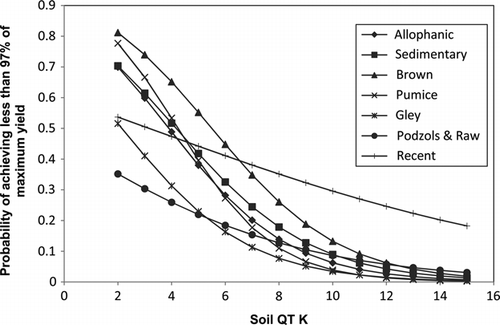
Reserve K
The reason most frequently invoked to explain why some soils are not responsive to fertiliser K, despite low QTK, is that they contain significant amounts of reserve K (plant-available but non-exchangeable soil K) that can be released at a rate sufficient to meet the pasture requirements.
The response functions for a subset of trials from the database for which both soil QTK and TBK were available are shown in ; these include data from allophanic and sedimentary soils. It appears that both tests are similar in their ability to predict pasture K responses on both sedimentary and volcanic soils. This should not be surprising for this set of data, because both soil QTK and TBK are correlated, allowing for the two outliers (see insert in ), implying that they are measuring different but related pools of soil K. Based on these data, near-maximum pasture production corresponds to QTK > 6 or TBK > 1.0. However, it is predominantly the volcanic soils, which do not normally contain significant amounts of reserve K (Metson Citation1980), that are non-responsive at low soil QTK and indeed at low TBK levels, suggesting that there must be another explanation for this feature in the data.
Fig. 3 Relationship between relative pasture production and soil K, measured as exchangeable K (soil QTK (Hogg Citation1957)) or as reserve K (exchangeable K plus soil K extracted with tetra-phenol-boron (TBK) (Jackson Citation1985)) for a subset of trials that comprised both QTK and TBK measurements on sedimentary (□) and allophanic soils (▪). The inset shows the relationship between QTK and TBK for this set of trials.

Williams et al. (Citation1986) reported that soil-exchangeable K (but not QTK) was more highly correlated to relative yield than TBK on a set of 13 trials under high rainfall (4000–8000 mm annually) on the West Coast, distinguished by their low and narrow range in soil K levels (QTK < 4). They noted that, for these soils, there were significant quantities of reserve K (TBK), but not exchangeable K, at depth (15–30 cm) that may have accounted for their lack of responsiveness to fertiliser K.
To explore this further, the original criteria for trial selection were relaxed to include all those trials with at least one rate of fertiliser K (i.e. a control and fertiliser K treatment) for which both QTK and TBK were measured. For this subset of trials, which included both volcanic and sedimentary soils, the response to fertiliser K (expressed as a percentage) was taken as the difference between the control and the highest rate of K treatment available for that trial. This is, of course, less rigorous than computing the predicted maximum production for the rates of K treatments. These results are shown in , with the Flexi function added. Once again, the relationships between relative pasture production and soil QTK or TBK are very similar although there is some suggestion from the data (i.e. the removal of two trials with relative yields >100% and QTK < 3) that the TBK test better accounts for some sites with low soil QTK that are not responsive to applied K, but the difference is small. The critical levels to achieve 97% relative yield are 7 (5–9) (QTK) and 1.3 (1.0–1.6) (TBK), consistent with the data in for sedimentary and brown soils.
Fig. 4 Relationship between relative pasture production and soil K: (a) measured as exchangeable K (soil QTK (Hogg Citation1957)) and (b) measured by reserve K (exchangeable K plus soil K extracted with TBK (Jackson Citation1985)) for a subset of sites including data from trials with only two K treatments (see text). The hatched bands are the 95% confidence intervals.
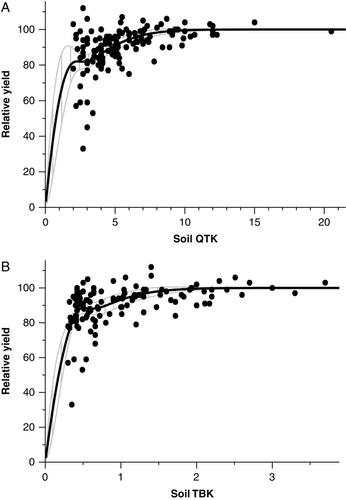
From this subset, a further subgroup of trials was selected for which the relative yield were ≥95% and soil QTK < 5. The relationships between relative pasture response to fertiliser K and soil K (both QTK and TBK) for these sites are shown in . For both soil tests there are four sites with low soil QTK and TBK that are not responsive (relative yield ≥100%). Of these four sites, two are on volcanic soils and two on sedimentary soils. Once again, this evidence suggests that some other explanation for this feature in the data is required. For the two trials on volcanic soils, the effect of applied K (80 kg ha−1 yr−1) on pasture production at each harvest and clover cover (assessed visually) over three years is shown in . Despite the low soil QTK and TBK, K application had little measurable effect on total pasture production (average annual relative yields of 95% and 103% respectively). However, the effect of fertiliser K on the clover content of the pasture was very marked, suggesting that clover is a more sensitive indicator of the responsiveness of pastures to applied K. The full implication of this in terms of measuring and predicting fertiliser K responses in clover-based pastures will be discussed in detail in the next section.
Fig. 5 Relationship between relative pasture production and soil K (a) measured as exchangeable K (soil QTK (Hogg Citation1957)) and (b) reserve K (exchangeable K plus soil K extracted with TBK (Jackson Citation1985)) for a subset of sites from the data in for which the relative pasture production was ≥95% and soil QTK <5.
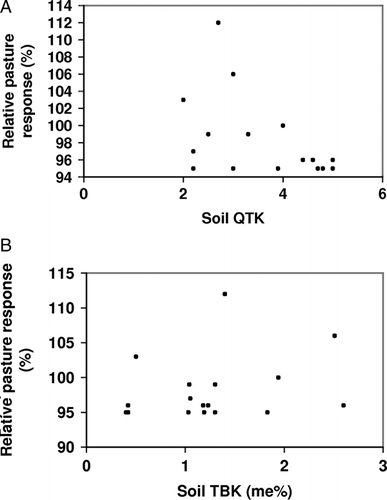
Fig. 6 The effect of potassium application (80 kg ha−1 yr−1) on pasture production (kg DM ha−1 per harvest) and pasture clover cover (% as measured visually) at each harvest date over three years on two trials ((a) and (b)) on volcanic soils with low soil QTK (2) and TBK (<0.5%) (data from Gillingham & Gray Citation2007).
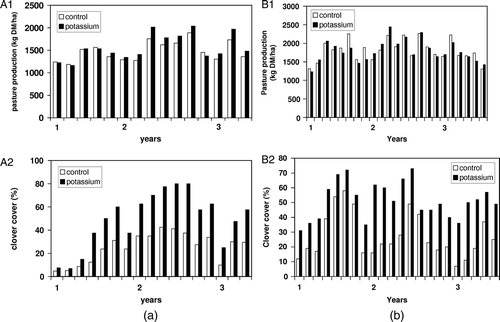
A series of K trials on pasture was reported by Morton et al. (Citation1998). These trials ran for only one year, on eight sites covering the major soil groups and climates in New Zealand. Both soil QTK and TBK were measured, and the same technique was used to measure both total pasture production and clover production. These results are summarised in . Neither test predicted total pasture production but the TBK test was related to clover production.
Fig. 7 Relationships between soil K (QTK and TBK 0–75 mm) and total pasture production and clover production for QTK (a) and TBK (b) on eight trials covering a range of soil groups and climate zones (see text).
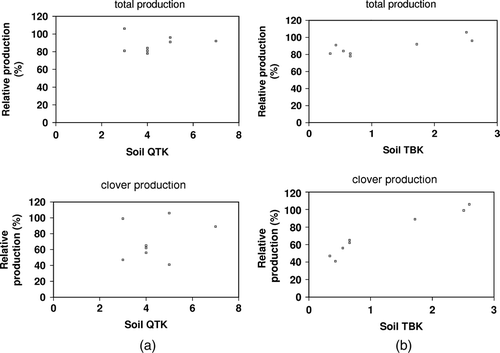
Thus, in summary, there is very little evidence at present to support the view that the soil TBK test is superior to the QTK test in terms of predicting total pasture production on sedimentary, allophanic and pumice soils. However, the suggestion emerges that the clover component of legume-based pastures is, firstly, more sensitive to soil K deficiency and, secondly, that TBK is a better predictor of this across soil groups. Further work is required to advance these ideas further.
At present, the TBK test is used in advisory work as a supplement to QTK, particularly when working on sedimentary soils. If significant amounts of TBK are measured (TBK > 0.80–1.2), then the fertiliser K inputs may be reduced accordingly (Morton & Roberts Citation1999; Roberts & Morton Citation1999). This current use of the TBK test may need to be reconsidered in the light of the results and suggestions above.
Temporal effects
Data were presented earlier showing that on K-deficient soils, responses to fertiliser K in the clover component of the pasture are more immediate and more pronounced than total pasture production. shows further evidence of this on two sites, one in the Waikato on an allophanic soil and the other in Southland on a brown soil. Both trials ran for 2 years under a clippings return regime. It is clear that increases in clover production were apparent almost immediately, but that the increases in total production took time to develop. This was not due to a decline in the soil QTK level on the control plots, and has been observed elsewhere in legume-based pastures (Spencer & Govaars Citation1982; Morton et al. Citation1999). Furthermore, there is much other evidence indicating that the clover component of mixed pastures is the first to respond to K application on K-deficient soils (Meissner & Clarke Citation1979; Spencer & Govaars Citation1982; Ledgard et al. Citation1997; Bolland et al. Citation2002; Mosquera-Losada et al. Citation2004; Gillingham & Gray Citation2007). This is most likely due to legumes’ higher requirement for soil K than grasses (Spenser & Govaars 1982; Bolland et al. Citation2002). Thus, the present results can be explained as follows. Because clover has a higher external requirement for K, it is the first to respond to fertiliser K applications; given time, and assuming that some of the clover N is returned to the soil, grass growth increases due to the increased amount of available soil N. In time, total pasture production increases. This may explain why in some trials total pasture production does not increase initially with fertiliser K applications, although the soil K level is low. It is noted that this logic applies, in clover-based pastures, to the measurement of pasture responses to all deficiencies of nutrients that act initially and primarily by promoting clover growth (particularly P, S, Mo (molybdenum) and Mg (magnesium)). It arises in the context of this discussion only as an attempt to explain the large variability in K pasture production functions.
Uptake of K from below 75 mm depth
A further explanation for the lack of pasture responses to fertiliser K at low soil QTK levels (0–75 mm) is the possibility that pasture plants take up considerable amounts of K from below the soil sampling depth. This has been suggested by many authors (Weeda Citation1978; During & Campkin Citation1980; Williams et al. Citation1990; Carey & Metherell Citation2003b), essentially to explain the results of K balance studies. This plant-available K below 75 mm depth may be from natural sources—the result of weathering—or it could be from past and indeed current (see next section) fertiliser applications. Related to this, urine K is the major flux of K back onto grazed pastoral soils and it is now understood that although urine K can be ‘lost’ from topsoil by preferential flow (Williams et al. Citation1989), it is not necessarily lost from the soil–plant system (Monaghan et al. Citation1999).
To reinforce this point, data from four pasture K trials reported by Morton et al. (Citation1999) and Carey & Metherell (Citation2003b) are summarised in . In these trials, changes in soil QTK over time accounted for <20% of the pasture K uptake and the standard TBK test accounted for <40%. Even very extreme extraction of the topsoil did not account for the pasture K uptake. Similar results were reported for other trials. Carey & Metherell (Citation2003b) concluded ‘failure of net changes in K reserve status to adequately account for K removal in nutrient budgets appeared best explained by significant plant uptake below the soil sampling zone (0–75 mm)’.
Table 2 Annual pasture K uptake and annual changes in soil QTK, soil TBK (1 h) and TBK (168 h) for four trials on sedimentary soils in Otago.
Movement of fertiliser K
The production functions for podzols & sands, organic, recent and gley soils are essentially flat over the range QTK 2–10, and relative pasture production is close to 100% over this same range (). As noted earlier, this could simply reflect the fact that there are insufficient data for these soil groups from which to accurately define the K response functions. It could also be due to the uptake of K from the soil below the sampling depth (as discussed above), but it is unlikely to be due to the presence of reserve K in the 0–75 mm layer—these soils will predictably have low levels of reserve K in the topsoil (Metson Citation1980).
Typically, such soils have little ability to retain K. They frequently occur under high rainfall conditions (>1000 mm yr−1 and frequently higher); some, such as the sands and developed organic soils, are free-draining and most will have a low effective cation exchange capacity (CEC, measured at the field pH). It is possible that for this set of soils, applied fertiliser K is readily leached beyond the soil sampling depth of 0–75 mm within the time frame of the experiment, from where it could still be utilised by the plant. Weeda (Citation1978) and During & Campkin (Citation1980) showed that pasture plants could extract K from down to 30 cm. Ozanne et al. (Citation1965) showed this explicitly using radioactive K, and found that plant K uptake at various depths was related to the quantity of roots present.
Williams et al. (Citation1986) measured the recovery of K in pasture across 13 sites (mowing trials with 70% return of clippings) on the West Coast on recent and gleyed soils under high rainfall. The recoveries were low: 17, 17 and 19 for fertiliser inputs of 30, 60 and 120 kg K ha−1 yr−1. The effects of fertiliser K on QTK (0–75 mm) were very small (average 0.2, range −0.2 to 1.2 QTK units), accounting for about 3 (−3 to 17) kg K ha−1. On some soils there was evidence that some fertiliser K was retained at the 75–150 mm depth, particularly as TBK, indicating that the release of K from non-exchangeable sources is reversible.
The results from a series of mowing trials with clippings returned (O'Connor et al. Citation2001) on organic soils in the Waikato (rainfall approx. 1200 mm yr−1) are shown in . Six sites were on undeveloped organic soils (defined as those with an anion storage capacity (ASC) <60) and a further six were on developed organic soil (ASC > 60) and for each site there were six rates of fertiliser K applied (0–100 kg K ha−1 yr−1). The data shown are the average pasture production for each rate of fertiliser K applied, on either the developed or undeveloped soils.
Fig. 9 Relationship between pasture production and soil QTK for six developed organic soils (♦) and six undeveloped organic soils (⋄). Mean effects over 3 years for the six sites (from O'Connor et al. Citation2001).
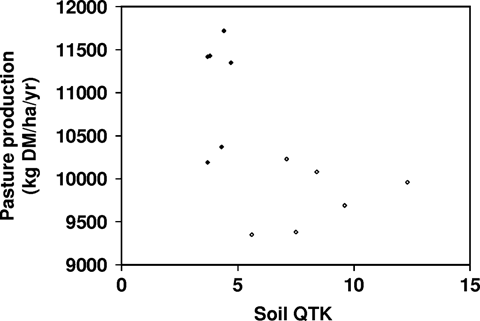
For the undeveloped peat, the soil QTK (0–75 mm) increased with increasing rate of fertiliser K applied from (on average) 5 to 12, indicating that some fertiliser K was being retained in the top 75 mm of soil. This increase in soil QTK over 3 years accounts for about 175 kg K ha−1 from a total of 300 kg K ha−1 applied. It is likely therefore that some of the fertiliser K leached below 75 mm depth. The relationship between pasture production and QTK is, however, relatively flat (there was a significant response up to 40 kg K ha−1 yr−1 of about 9%), and is consistent with the conclusion that the relative pasture production is not greatly affected by soil QTK levels above 5, due to the uptake of fertiliser K leached below 75 mm.
This argument is greatly reinforced by the data from the developed peat. For these sites, the application of fertiliser K had very little effect on soil QTK levels, similar to the results reported by Williams et al. (Citation1986) as discussed above, suggesting that most of the fertiliser K was leached below 75 mm within the time frame of the experiments (3 years) from where it was taken up by the pasture. For this subset of trials there was a pasture response up to 40 kg K ha−1 yr−1 of about 12%, with no associated change in QTK.
Thus the accumulated evidence makes it highly probable that pastures can and do take up considerable K (either derived from weathering of soil minerals or from past and current fertiliser inputs) from below the normal soil sampling depth (0–75 mm) used in advisory work. This being so, and given the quantities involved (), relative to the amounts of available K in the topsoil (0–75 mm), it is perhaps surprising that there is any relationship between QTK (0–75 mm) and pasture responses to applied K (). The fact that there is a relationship—albeit a weak one—implies that soil QTK, or indeed TBK, to a depth of 0–75 mm may be a surrogate for the total plant-available K in the profile accessible to the plant. This needs to be explored further because, if it is true, further research developing soil tests to measure plant-available soil K in the 0–75 mm depth may be in vain.
Components of K production functions
Building on the work of Sinclair et al. (Citation1997) with respect to soil P, Edmeades et al. (Citation2006) formalised the sources of variation in P production functions. Applying the same methodology, the pool of soil K available for plant growth can be conceptualised as follows
Critical K levels
Soil tests
If it is assumed that the goal is to achieve 97% maximum production, then generalising from the data in , it is reasonable to suggest critical levels for the sedimentary and volcanic soils to be in the range 5–8 and 7–10, respectively. These equate to ranges of about 100–160 and 140–200 µg K g−1 soil. Hogg (Citation1957) suggested a critical level for allophanic and pumice soils of 200 µg K g−1 soil.
These results are consistent with other data on temperate soils. Based on data from 23 sites in New South Wales (Australia), Spenser & Govaars (1982) estimated the critical exchangeable K concentration to be 280 µg g−1 soil (0–75 mm) for the legume (subterranean clover) component in their pastures and a lower concentration (about 120 µg K g−1) for the total pasture. From data derived from 180 legume-based pasture trials in Victoria, Australia, 100% maximum yield was achieved if the exchangeable K (dilute HCl) was about 200 µg g−1 (0–100 mm) (Gourley Citation1989). Bolland et al. (Citation2002) reported that for subterranean pastures in Western Australia, no responses to the clover component if the Colwell K (0–100 mm) concentration was >100 µg g−1; these were all 1-year trials at 100 sites. Of interest, given that lucerne is a tap-rooted legume, the soil QTK (0–75 mm) required for 97% maximum production of lucerne on three sites in Southland was about 7 (140 µg K g−1 soil) (Risk & Smith Citation1992). Thus, it is reasonable to suggest that the critical level for legume-based pasture for maximum production is in the range 150–250 µg g−1, allowing for the vagaries inherent in such comparisons.
Pasture tests
There also appears to be good agreement that the critical concentration of K in legumes (white clover, subterranean clover and lucerne) for maximum production is in the range 1.5–2.0% (Andrew & Robins Citation1969; Spencer & Govaars Citation1982; Risk & Smith Citation1992; Morton & Roberts Citation1999; Morton et al. Citation1999; Roberts & Morton Citation1999; Bolland et al. Citation2002). Morton et al. (Citation1998)summarised a large amount of data from eight field trials covering a wide range of soils and climatic zones in New Zealand and concluded that the critical level in white clover was 2.05% K.
There are very little data reported on the critical concentration required for grasses. Clough (Citation1990) reported K concentrations required for 90% maximum production for ryegrass, prairie grass and cocksfoot of 2.8–3.2%, 3.1–3.7% and 1.5–2.2%, respectively. CitationSmith (undated) reported data from a factorial N × K on a pure ryegrass sward that, at the highest rate of fertiliser N applied, showed the maximum yield of ryegrass occurred at 1.5–2.0% depending on the season.
Morton et al. (Citation2001), applying the concept of balance and adequate nutrition, reported that balanced nutrition at 95% maximum production in a white-clover-based pasture was achieved when the K:P ratio was 6.9 in clover and 6.7 in mixed pasture. The comparable figures for K:N were 0.46 and 0.77, respectively.
K buffer capacity
To correct soil K deficiency, some knowledge of the amount of fertiliser K required to increase the soil K test is required. This can be referred to as the K buffer capacity (ΔK), which is the amount of fertiliser K, over and above maintenance, required to increase soil QTK by one unit in the field. shows ΔK values for all the available data for sedimentary soils (there is in fact very little information available for the other soil groups) relative to the initial soil QTK for each trial. Leaving aside the two extreme outliers, the data suggest that ΔK does not depend on the initial soil K status and that most of the data fall within the range 50–200 kg K ha−1 per unit increase in soil QTK. The average is 124. This is not dissimilar to data by Morton & Roberts (Citation1999) and Roberts & Morton (Citation1999) who reported ΔK values for sedimentary soils to be 125 (range 100–250). The reason for the wide range is not clear. It could reflect real differences in the chemistry of the soils in terms of their ability to retain K, or it could be the result of the intrusion of uncontrolled errors in the measurements and calculation used.
Fig. 10 Relationship between soil K buffer capacity (ΔK) and soil QTK for trials with no clippings returned (▪) and all clippings returned (□).
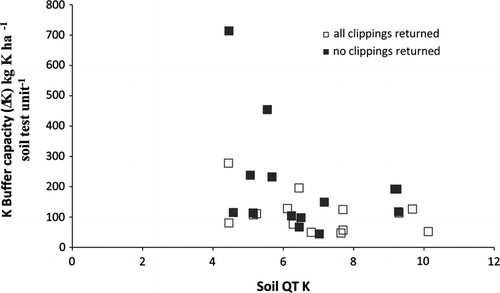
Morton & Roberts (Citation1999) and Roberts & Morton (Citation1999) calculated ΔK values for allophanic and pumice soils to be 60 (45–80) and 45 (35–60), respectively, suggesting that that the K buffer capacity of volcanic soils is less than that of sedimentary soil on average. shows, for seven sites on several different soil groups, soil QTK values measured at the conclusion of each trial, relative to the average annual K inputs. Note that not all these trials ran for the same number of years, and the measured soil QTK levels are the net result of inputs of K from fertiliser and all the losses of K over the duration of the trials. The slopes of these relationships suggest that the rate of change in soil QTK per unit K applied is similar for the different trials. This suggests, if it is assumed the total K losses where similar, that the buffer capacities are similar for this range of soil types, although the undeveloped organic soils appear to be exceptional. For the two allophanic soils, the estimated rate of change in soil QTK is 203 and 180 kg K ha−1 yr−1 per unit. Assuming that the total K losses are about 75 kg K ha−1 yr−1, this suggests ΔK of about 110–130, similar to the value for sedimentary soils.
Fig. 11 Relationship between soil QTK and annual K input for a range of soils on trials of different duration (duration of each trial in years in parentheses).
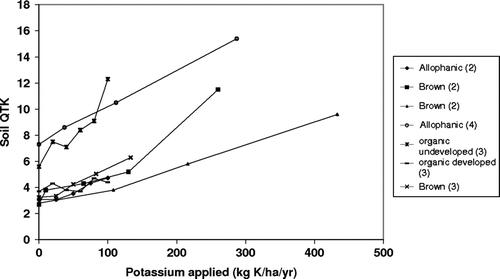
As discussed, there are some soils where inputs of fertiliser K are known to have very little effect on QTK (0–75 mm) levels, such as developed peat soils and soils on recent and gleyed soils on the West Coast. It seems reasonable to extend this to include the raw soils and podzols. The fact that QTK (0–75 mm) levels can be increased on undeveloped peat soils but not developed peat soils implies the role of organic matter and its effect on CEC. As peats develop they lose organic matter and hence the effective CEC will decline.
The range in the measured ΔK values could reflect differences in the rate of leaching of K and/or differences in the ability of soils to hold and retain K, related to the effective CEC of the soil (the CEC at field pH) and selectivity for K, relative to the other cations. This could be a useful area for future research.
The other point reinforced by these data is that large amounts of fertiliser K are required to increase soil QTK levels. Inputs of >100 kg K ha−1 yr−1 are required for several years to achieve increases of 1–2 soil QTK units. A further reason for the lack of pasture responses to applied K in some trials, at low soil QTK levels, may be that insufficient fertiliser K was applied at the outset.
It is also likely that, in practice, large inputs of fertiliser K will be resisted—even in situations of absolute soil K deficiency—because of the perceived link between fertiliser K inputs and animal health. It is not within the scope of this review to include a discussion of this field of literature. It is sufficient simply to draw attention to the body of New Zealand literature indicating that large inputs of fertiliser K may not have any significant effect on animal behaviour, production or health (Carruthers et al. Citation1987, Citation1988; Morton et al. Citation2005a, Citationb)
Maintenance K requirements
Once the desired soil QTK has been achieved, then maintenance inputs of K are required, maintenance being defined as the amount of fertiliser K required to maintain soil QTK. The available data are summarised in for trials in which no clippings were returned and trials in which all the clippings were returned. Maintenance K inputs increase as the soil K level to be maintained increases, presumably because K losses, particularly due to leaching, increase with increasing soil K. Understandably, maintenance K inputs are higher when more K is removed from the system (i.e. with clippings removed). In practice, commercial farms will fall between these extremes, suggesting very low maintenance inputs are required at low soil QTK levels and up to 200 kg K ha−1 yr−1 annually at higher soil QTK levels where total K losses (including leaching, animal transfer and product removed) are higher. This is consistent with predicted maintenance K requirements from modelling of 0–125 kg K ha−1 yr−1 (Campkin Citation1985) and the calculated total losses of K of 74–109 ha−1 yr−1 estimated from mass balance modelling (Williams et al. Citation1990).
Fig. 12 Relationship between soil QTK and calculated maintenance requirement for K for trials with no clippings returned (▪) and all clippings returned (□).
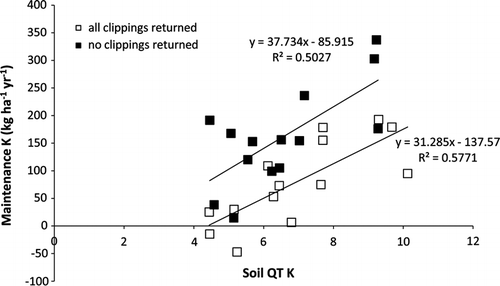
Assuming that the clippings-returned situation represents a near-closed system, with all the K taken up by the pasture returned to the soil, the calculated maintenance K inputs () should largely reflect K losses via leaching. For this set of data, the inferred leaching losses range from very small at low soil QTK levels up to about 150 K ha−1 yr−1 at soil QTK levels of about 10. This is generally consistent with measured losses of K by leaching under New Zealand conditions ranging from about 6 to 70 kg K ha−1 yr−1 (Campkin Citation1985; Morton et al. Citation2004; Monaghan et al. Citation1999, Citation2005; Early et al. Citation1998).
Managing uncertainty: application of the results
Given the lack of precision in soil QTK production functions and soil ΔK values, how best can this information be used in practice when making a fertiliser K recommendation, on a given site for a given landowner?
Some assessment of the goals and the risks of a given property seem to be essential. If, for example, the property is used for intensive agriculture and the production goal is high, then the desire would be to minimise any possibility that pasture production could be limited by K deficiency (soil QTK 10). In other situations, a more pragmatic approach can be adopted by aiming for soil QTK levels in a lower range, say 7–10 for volcanic soils and 5–8 for sedimentary soil, as is recommended presently (Morton & Roberts Citation1999; Roberts & Morton Citation1999). If the current soil QTK is less than these ranges, then other information should be sought: in particular, what is the fertiliser K history on the property, what are the trends in soil K levels over time, and importantly, what is the K concentration in the clover and the ratios of the nutrients K/P and K/N? Visual inspection of the pasture can also be helpful. If this combined information suggests an absolute K deficiency, then remedial action may be appropriate and the economics (cost and benefits) can be estimated using the OVERSEER® econometric model.
The uncertainty in ΔK can also be managed pragmatically by ensuring that there is a good soil test monitoring programme in place. If the recommended input of fertiliser K is above or less than what is required for a specific site, then in time this will become clear from the trends in soil QTK levels over time and adjustments made accordingly. This requires accurate soil testing and, of all the soil tests, QTK is one of the most variable (Edmeades et al. Citation1988). This problem is compounded when strict soil sampling protocols are not followed. It is essential, especially when assessing the soil K status, to avoid stock camps, fences, troughs, gateways and all urine patches. To do otherwise can result in inflated soil QTK levels.
Conclusions
The relationships between relative pasture production and soil QTK (0–75 mm)—the K production functions—for all soil groups for which there are sufficient data are generally flat in the range QTK 5–10; as a consequence, estimated relative pasture production at QTK 5 and QTK 10 is very similar. The critical QTK levels to achieve 97% maximum production were relatively well defined, being 6 (5–8) for sedimentary soils (brown and pallic) and brown soils, and 7 (5–10) for pumice soils. The best estimate for allophanic soils is 6 (5–10). For the remaining soil groups (podzols and sands, organic, recent and gley soils), much less information is available and the relationships are essentially flat over the range QTK 2–10. It was concluded that the probability of pasture responses to applied K increased as soil QTK decreased from 10. For the sedimentary and volcanic soils (including both allophanic and pumice), the probability of pasture response was about 70–80% at soil QTK <2. The comparable probabilities were 50–60% for the recent and gley soils, and 30–43% for the podzols and sands.
For subsets of trials for which both QTK and reserve K (0–75 mm, as measured by the tetra-phenol-boron test (TBK)) data were available, the response functions were very similar, suggesting that both tests are similar in terms of their ability to predict pasture responses to applied K.
It appears that, for all soil groups, there are situations in which pastures do not respond to applied K even though the soil QTK (0–75 mm) is low (<5). There is evidence to support a number of explanations for this. These include the temporal nature of total pasture responses to applied K indicating that it takes time (>2–3 years) for K responses in total production to be expressed and the presence of plant-available, but non-exchangeable, K as measured by the TBK test. However accounting for these factors has only a minor effect on predicting pasture response to fertiliser K. We conclude that the most likely reason for the variability in soil K pasture production functions (leaving aside errors in the measurement of pasture production) is the uptake of K (from both exchangeable and non-exchangeable K and including natural sources from weathering and past and current fertiliser and urine inputs) from below the soil sampling depth (0–75 mm).
The amounts of applied K, over and above maintenance, required to increase soil QTK (ΔK) ranged from 40 to 150 kg K ha−1 per soil QTK unit (average 124). It is not clear whether this range in ΔK is due to inherent variability in the data or reflects real differences in the ability of soils to absorb and retain applied K.
Predicted maintenance rates increased as the initial soil QTK level increased from zero at low QTK (<4) to about 150 kg K ha−1 yr−1 at soil QTK >10. Increasing the losses of K (removing all the pasture produced) increased the maintenance inputs, as expected.
There is good evidence to indicate that the critical level of K (the level required for near-maximum production) in legumes is in the range 1.5–2.0%.
If there is to be progress in improving the prediction of pasture to fertiliser K, the following areas of research are suggested.
-
Given that pastures can derive significant amounts of K from below the soil sampling depth and that there is some relationship between pasture K responses and soil QTK (0–75 mm), the current QTK test seems to be a surrogate for the total plant-available K in the soil profile. This hypothesis could be tested using national soil databases where K has been measured to depth in soil profiles.
-
It is unlikely, given the many soil and plant factors that affect pasture responsiveness to applied K, that further improvements in the precision of measuring soil K in the 0–75 mm depth, including the measurement of reserve K, will improve our current ability to predict pasture K responses. Further work on understanding how plants acquire K from the whole soil profile could be beneficial, especially if this can be related to easily measured soil properties.
-
It appears that clover is very sensitive to K deficiency and that clover production rather than total pasture production may be a better short-term (1–2 years) indicator of soil K responsiveness. Further research using either soil QTK or TBK to predict clover responses in mixed swards may be enlightening.
-
Further research is also required to determine whether the apparent differences in ΔK are due to soil properties (absorption and selectivity for K, for example) or whether they simply reflect the intrusion of uncontrolled errors in such measurements.
Acknowledgements
Mr Cor Feyter and his team undertook and completed the huge task of summarising all the past field trials and setting up the database. This review was funded by FertResearch.
References
- Andrew , CS and Robins , MF . 1969 . The effect of potassium on the growth and chemical composition of some tropical and temperate pasture legumes 1. Growth and critical percentages of potassium . Australian Journal of Agricultural Research , 20 : 999 – 1007 .
- Bolland , MDA , Cox , WJ and Codling , BJ . 2002 . Soil and tissue tests to predict pasture yield responses to applications of potassium fertiliser in high-rainfall areas of south-western Australia . Australian Journal of Experimental Agriculture , 42 : 149 – 164 .
- Campkin , R . 1985 . Model for calculating potassium requirements for grazed pastures . New Zealand Journal of Experimental Agricultural , 13 : 27 – 37 .
- Carey , PL and Metherell , AK . 2003a . Rates of release of non-exchangeable potassium in New Zealand soils measured by a modified sodium tetraphenyl-boron method . New Zealand Journal of Agricultural Research , 46 : 185 – 197 .
- Carey , PL and Metherell , AK . 2003b . Monitoring long-term changes in reserve potassium in some New Zealand soils using a modified sodium tetraphenyl-boron method . New Zealand Journal of Agricultural Research , 46 : 199 – 213 .
- Carruthers , VR , O'Connor , MB , Feyter , C , Upsdell , MP and Ledgard , SF . 1987 . Results from the Ruakura bloat survey . Proceedings of the Ruakura Farmers Conference , 39 : 44 – 46 .
- Carruthers , VR , Norton , DH and O'Connor , MB . 1988 . The incidence of bloat in pastures differing in K:Na ratio . Proceedings of the New Zealand Grassland Association , 49 : 169 – 170 .
- Clough , TJ . 1990 . Response of Yatsyn ryegrass, Matua prairie grass and Wana cocksfoot to phosphorous and potassium . Proceedings of the New Zealand Grasslands Association , 51 : 167 – 170 .
- During , C and Campkin , R . 1980 . Sources of potassium taken up by ryegrass from some soils of the North Island . New Zealand Journal of Agricultural Research , 23 : 85 – 91 .
- Early , MSB , Cameron , KC and Fraser , PM . 1998 . The fate of potassium, calcium, and magnesium in simulated urine patches on irrigated diary pasture soil . New Zealand Journal of Agricultural Research , 41 : 117 – 124 .
- Edmeades , DC . 1995 . “ Modeling nutrient requirements—AgResearch's approach ” . In Fertiliser requirements of grazed pastures and field crops , Edited by: Currie , LD and Loganathan , P . 9 – 11 . Massey University Occasional Report No 8 .
- Edmeades , DC , Cornforth , IS and Wheeler , DM . 1988 . Soil: testing, getting maximum benefit , Wellington, , New Zealand : Primedia, Ministry of Agriculture and Fisheries .
- Edmeades , DC , Thorrold , BS and Roberts , AHC . 2005 . The diagnosis and correction of sulfur deficiency and the management of sulfur requirements in New Zealand pastures: a review . Australian Journal of Experimental Agriculture , 45 : 1205 – 1223 .
- Edmeades , DC , Metherell , AK , Waller , JE , Roberts , AHC and Morton , JD . 2006 . Defining the relationships between pasture production and soil P and the development of a dynamic P model for New Zealand pastures: a review of recent development . New Zealand Journal of Agricultural Research , 49 : 207 – 222 .
- Gillingham AG , Gray MG 2007 . Derivation of hill pasture response to K fertiliser . Report prepared for Ballance AgriNutrients and Agrow Australia Pty .
- Gourley , CJP . 1989 . Predicting the responsiveness of pasture to potassium fertiliser in Victoria . Australian Journal of Experimental Agriculture , 29 : 377 – 382 .
- Hewitt , AE . 1993 . New Zealand soil classification. Landcare Research Science Series 1 , Lincoln, , New Zealand : Landcare Research New Zealand Ltd .
- Hogg , DE . 1957 . The assessment of available potassium in soils . New Zealand Journal of Science and Technology , 38A : 1015 – 1024 .
- Jackson , BLJ . 1985 . A modified sodium tetraphenylboron method for routine determination of reserve-potassium status of soil . New Zealand Journal of Experimental Agriculture , 13 : 253 – 262 .
- Kirkman , JH , Basker , A , Surapaneni , A and MacGregor , AN . 1994 . Potassium in the soils of New Zealand—a review . New Zealand Journal of Agricultural Research , 37 : 207 – 227 .
- Ledgard , SF , Roach , CG and Sowry , SR . 1997 . N, P, K research at the Te Kuiti Research Station. Proceedings of the New Zealand Fertiliser Manufacturers . Association Technical Conference , 24 : 112 – 117 .
- Martin DR , Clark JP , 2000 . More money for your mineral . Proceedings of New Zealand Minerals & Mining Conference , 29–31 October 2000 .
- Meissner , AP and Clarke , AL . 1979 . Effectiveness of single and annual applications of potassium fertiliser on mown pasture in south-eastern South Australia . Australian Journal of Experimental Agriculture and Animal Husbandry , 19 : 599 – 604 .
- Metson , AJ . 1960 . Some factors affecting the potassium status of New Zealand soils . Potash Review , 4 : 1 – 10 .
- Metson , AJ . 1968 . Potassium . New Zealand Soil Bureau Bulletin , 26 : 82 – 95 .
- Metson AJ 1980 Potassium in New Zealand Soils . Wellington , NZ Soil Bureau , Scientific Report 38 .
- Monaghan , RM , Carey , P , Metherell , AK , Singleton , PL , Drewry , J and Addison , B . 1999 . Depth and distribution of simulated urine in a range of soils soon after deposition . New Zealand Journal of Agricultural Research , 42 : 501 – 511 .
- Monaghan , RM , Paton , RJ , Smith , LC , Drewry , JJ and Littlejohn , RP . 2005 . The impacts of nitrogen fertilization and increasing stocking rate on pasture yield, soil physical condition and nutrient losses in drainage from cattle-grazed pasture . New Zealand Journal of Agricultural Research , 48 : 227 – 240 .
- Morton , JD and Roberts , AHC . 1999 . Fertiliser use on New Zealand sheep and beef farms , Auckland : New Zealand Fertiliser Manufacturer's Research Association .
- Morton , JD , Smith , LC and Morrison , JD . 1998 . Clover nutrient ratios to monitor pasture yield responses to fertiliser nutrients . Proceedings of the New Zealand Grasslands Association , 60 : 141 – 148 .
- Morton , JD , Smith , LC and Metherell , AK . 1999 . Pasture yield responses to phosphorus, sulphur, and potassium applications on North Otago soils, New Zealand . New Zealand Journal of Agricultural Research , 42 : 133 – 146 .
- Morton , JJ , Smith , LC , Dodds , KG and Catto , WD . 2001 . Balanced and adequate potassium and phosphorus nutrition of pasture . New Zealand Journal of Agricultural Research , 44 : 269 – 277 .
- Morton , JD , Roach , CG , Tong , MJ and Roberts , AHC . 2004 . Potassium in soil and pasture and leaching of cations on an allophanic soil in New Zealand . New Zealand Journal of Agricultural Research , 47 : 147 – 154 .
- Morton , JD , Roach , CJ and Roberts , AHC . 2005a . Effect of the rate of potassium chloride on dairy production in Taranaki . Proceedings of the New Zealand Grasslands Association , 67 : 67 – 71 .
- Morton , JD , Roach , CJ and Roberts , AHC . 2005b . Effect of potassium content and dusting of sodium chloride on the pasture preference of dairy cows . New Zealand Journal of Agricultural Research , 4 : 29 – 37 .
- Mosquera-Losada , MR , Gonzalez-Rodriguez , A and Rodriguez , AR . 2004 . Fertilisation with nitrogen and potassium on pastures in temperate area . Journal of Range Management , 57 : 280 – 290 .
- O'Connor , MB , Longhurst , RD , Johnston , TJM and Portegys , FN . 2001 . Fertiliser requirements for peat soils in the Waikato region . Proceedings of the New Zealand Grasslands Association , 63 : 47 – 51 .
- Ozanne , PG , Usher , CJ and Kirton , DJ . 1965 . Root distribution in a deep sand and its relationship to the uptake of added potassium by pasture plants . Australian Journal of Agriculture Research , 16 : 785 – 800 .
- Risk , WH and Smith , LC . 1992 . Fertiliser requirements of lucerne cut for hay in northern Southland . Proceedings of the New Zealand Grasslands Association , 54 : 59 – 63 .
- Roberts , AHC and Morton , JD . 1999 . Fertiliser use on New Zealand dairy farms , Auckland : New Zealand Fertiliser Manufacturer's Research Association .
- Saunders , WMH , Sherrell , CG and Gravett , IM . 1987 . A new approach to the interpretation of soil tests for phosphate responses by grazed pastures . New Zealand Journal of Agricultural research , 30 : 67 – 77 .
- Sinclair , AG , Johnston , PD , Smith , LC , Roberts , AHC , O'Connor , MB and Morton , JD . 1997 . Relationship between pasture dry matter yield and soil Olsen P for a series of long-term field trials . New Zealand Journal of Agricultural Research , 40 : 559 – 567 .
- Smith LC undated . Determination of optimum ratios of potassium to nitrogen in ryegrass pastures: final report on production data, soil and plant analysis . Woodlands , NZ , AgResearch Ltd, Report IW 858/43/95 .
- Spencer K , Govaars AG 1982 . The potassium status of pastures in the Moss Vale District, New South Wales . Canberra , Commonwealth Scientific and Industrial Research Organization , Division of Plant Industry technical paper No. 38 .
- Surapaneni , A , Tillman , RW , Kirkman , JH , Gregg , PEH and Roberts , AHC . 2002 . Potassium-supplying power of selected pallic soils of New Zealand 1. Pot trial study . New Zealand Journal of Agricultural Research , 45 : 113 – 122 .
- Upsdell , MP . 1994 . Bayesian smoothers as an extension of non-linear regression . New Zealand Statistician , 29 : 66 – 81 .
- VSN 2005 . GenStat 2005 version 8.1.0.156, Eighth edn . VSN International Ltd , Oxford .
- Weeda , WC . 1978 . Observations on the depth of removal of soil potassium and magnesium by permanent grass/clover pasture . New Zealand Journal of Experimental Agricultural Research , 6 : 327 – 8 .
- Williams , PH , Morton , JD and Jackson , BLJ . 1986 . Chemical soil test prediction of pasture responses to potassium on recent soils of the South Island west coast . New Zealand Journal of Experimental Agricultural , 14 : 411 – 415 .
- Williams , PH , Hedley , MJ and Gregg , PEH . 1989 . Uptake of potassium and nitrogen by pasture from urine-affected soil . New Zealand Journal of Agricultural Research , 32 : 415 – 452 .
- Williams , PH , Gregg , PEH and Hedley , MJ . 1990 . Mass balance modeling of potassium losses from dairy pasture . New Zealand Journal of Agricultural Research , 33 : 661 – 668 .
